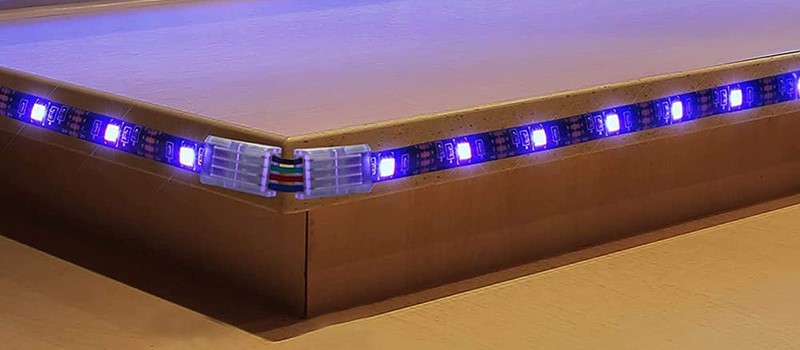The use of LED strip lights is inseparable from connectors. In the installation of LED strips, you may encounter difficulties. Usually, a small LED accessory can help you solve some seemingly insurmountable obstacles very well. Now, let’s see how useful the LED strip light connectors can be.
- What Are LED Light Connectors?
- How To Connect Cut LED Strip?
- How To Install LED Strip Lights In A Corner?
- How To Install LED Strip Lights On Uneven Surfaces?
- How Do Two Parts With Different Connections Work?
- Do All LED Strip Lights Use The Same Connectors?
- How To Distinguish SMD LED Connector And COB LED Connector?
- Can I Use Connectors For Waterproof LED Strip Lights?
What Are LED Light Connectors?
LED light connectors are small, lightweight electrical parts commonly used in LED lighting applications, to link LED lighting fixtures to each other and to controller or power sources.
They are available in a variety of types, sizes, and shapes, and can be easily inserted and removed from LED light wiring.
Benefits of using LED Light Strip connectors: various types, easy to use, no complex electrical knowledge required.
How To Connect Cut LED Strip?
It is inevitable to cut LED strips to fit the length of your installation. By using different connectors, the cut strip can be connected to another section of strip, controller or power supply.
- Two sections of strip connected

2) The strip is connected to the controller or power supply

How To Install LED Strip Lights In A Corner?
During LED strip installation, when encountering a corner, people usually choose to wrap the light strip around to change its direction of travel. But this is not an excellent solution, and that protruding piece will ruin your entire lighting aesthetic.
The best solution is to use a corner connector, which has an L-shaped appearance and is perfect for 90-degree corners.
- This LED connector is suitable for 2 Pin 10mm/8mm single color led strip lights, 3pin 10mm CCT dimmable white led strip lights, 4pin 10mm RGB led strip lights, 5pin RGBW 10mm/12mm led strips, 6pin RGBCCT 12mm led strips;
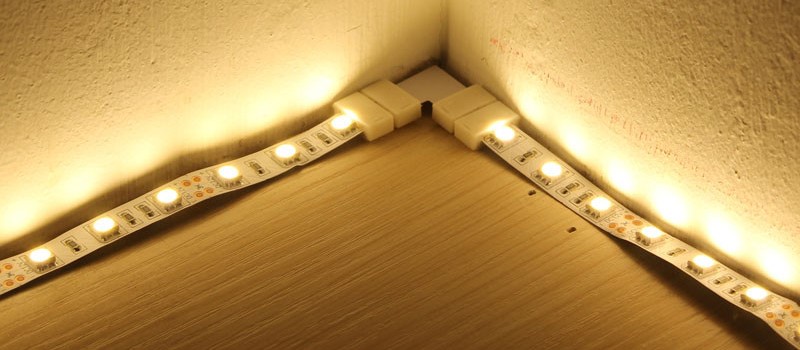
- This 2 pin led connector is for 8/10mm strip lights;
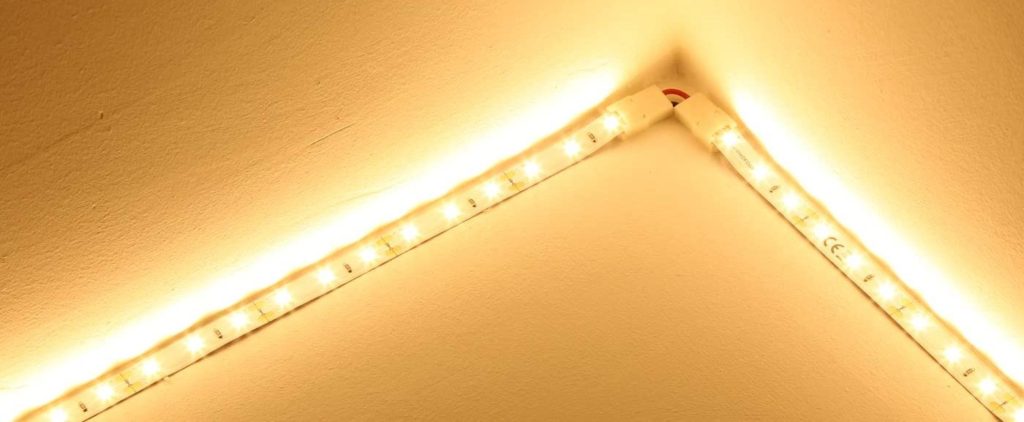
- This transparent COB LED corner connector is applied to 2pin 5mm/8mm/10mm, 3pin CCT 8mm/10mm, 4pin RGB 10mm light strips;
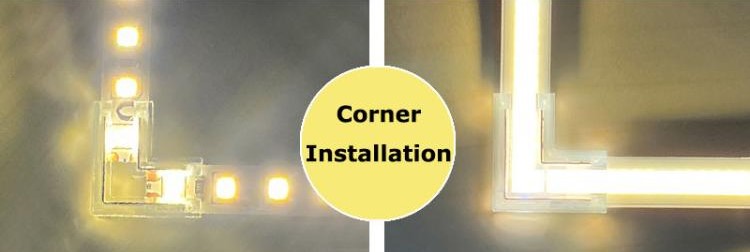
- This L-shaped corner connector with transparent plastic material is suitable for RGB 4pin 10mm, RGBW 5pin IP20/IP65 10mm/12mm, 6pin 12mm strip lights;
- This snap connector with screw holes is suitable for 2pin 4pin 10mm light strip;
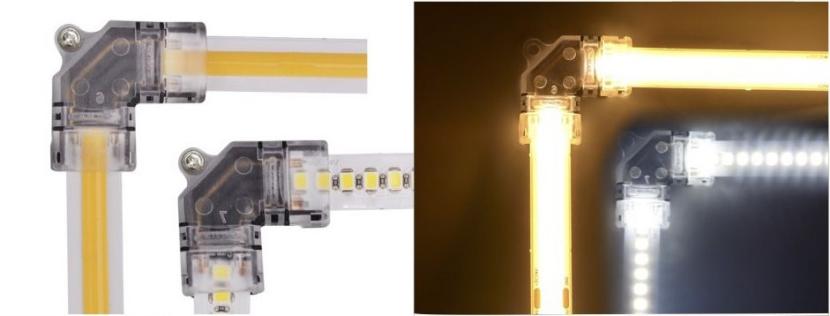
There are also L-type connectors for connecting 4-pin terminal RGB strips and high voltage led strips. The 90-degree connector is ideal for ceiling light strip mounting, cove lighting mounting, and TV backlight mounting, etc.
How To Install LED Strip Lights On Uneven Surfaces?
Installing LED lights on a straight flat surface, whether it is a flexible LED strip or a LED light bar, it can be well adapted to it. But if there is a protrusion, the LED light will not fit well on this surface, and this time you need to take some measures.
Cut the LED strip at the protrusion, and use a connector with an extension cord in the middle to connect the two sections of the strip to jump the obstacle. This way they all use the same power supply.
You can even use an extension cord accessory between two connectors of the same type to extend the distance between these two sections of light strips.
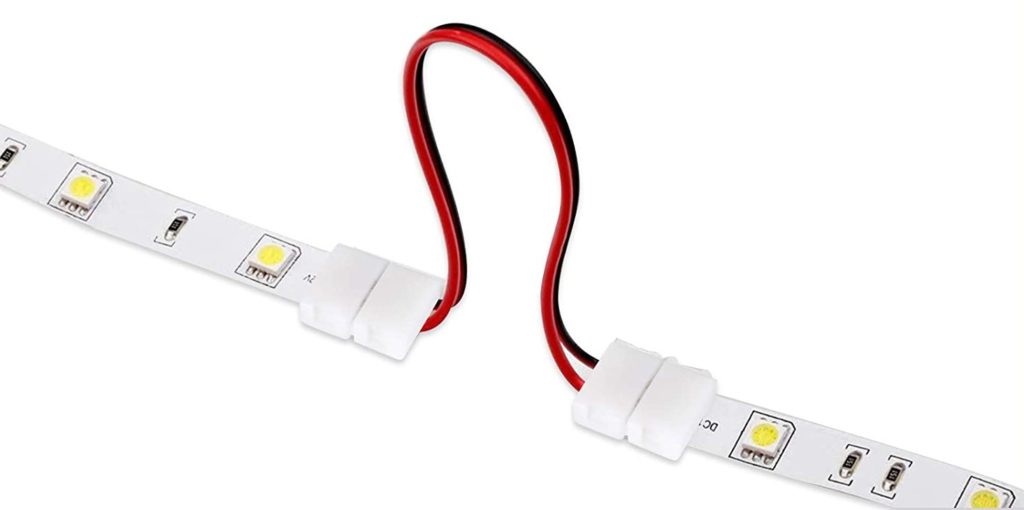
How Do Two Parts With Different Connections Work?
The presence of LED strip connectors allows different connection interfaces to work together, including two strip with different interfaces, strip and controller, strip and power supply, etc. Your stock LED accessories can come in handy.
- Strip to wire, this type of connector is very friendly for cut-out strips, you can easily power the strip or control the LED light changes;
- Strip to DC female connector, for low voltage single color led strips connected directly to a power adapter or controller.
- USB to DC male connector, for 5V led strips
- 4pin/5pin terminal end to strip, for connecting the led lights to the controller. Most LED controllers are hard-wired type, but there are some controllers with other interfaces.
- Strip to 3pin JST connector, this works for addressable led strips after cutting
Do All LED Strip Lights Use The Same Connectors?
Each LED strip has its own unique connector style, and not one connector is universal for all strips. You need to start from the needs of the strip itself. Its pin point, PCB width, whether waterproof, your purpose, etc. are all factors that need to be considered.
For example, if you want to choose a connector for your 10mm wide non-waterproof SMD RGB strip lights, then your keyword has to be 4pin, for RGB LED strip lights, 10mm PCB width, non-waterproof/IP20, for SMD LEDs.
How To Distinguish SMD LED Connector And COB LED Connector?
The pin points of SMD LED strip are evenly distributed, and the spacing between each pin point is very even. So the metal sheet of SMD LED connector is also distributed evenly.
But COB LED strips have pin points only distributed on both sides due to the middle capping layer, so you can see that the metal connection points of COB LED connectors are distributed on both sides.
And because of the height of the sealing layer, the COB LED connector must also be able to accommodate it.
LED connectors suitable for a particular strip type must be designed according to the characteristics of that strip.

Can I Use Connectors For Waterproof LED Strip Lights?
Snap connectors can be used for IP65 led strips, they are rated for waterproof use. Peel off the adhesive backing, align the strip pin points with the connector metal pins, and press the cover to let the metal pins pierce the PCB to establish an electrical connection.
There are board-to-board and board-to-wire connector types.
